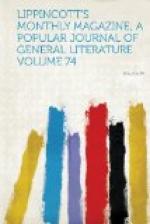“America has no monuments,” say our Transatlantic cousins, “because it is but two hundred years old.” Well, Australia, with little more than three-quarters of a hundred, has already its monument—a beautiful bronze monument erected to the memory of the explorers Burke and Wills on a lofty pedestal of elegant workmanship, and occupying a commanding eminence in the city of Melbourne. The figures, two in number, are of more than life size, one rising above the other—the chief, with noble form and dignified air, fraternally supporting his younger confrere. The pedestal shows three bas-reliefs of exquisite design—one the return to Cooper’s Creek,
[Illustration: Bas-relief: Return to Cooper’s Creek.]
where the torn garments and emaciated limbs tell with sad emphasis the woeful tale of hardship and toil through which the heroic explorers had been passing; another exhibiting the subsequent death of Burke;
[Illustration: Bas-relief: Death of Burke.]
and the third the finding of the remains.
[Illustration: Bas-relief: Finding of Burke.]
Burke and Wills, to whom belongs the honor of being the first explorers that crossed the entire continent of Australia, extending their researches from the Australian to the Pacific Ocean, set out on the 20th of August, 1860, with a party of fifteen hardy pioneers upon their perilous mission. Burke was in the prime of life, a man of iron frame, dauntless courage and an enthusiasm that knew neither difficulty nor danger. Wills, who belonged to a family that had already given one of its members to Sir John Franklin’s fatal expedition, to find a martyr’s grave among the eternal icebergs of the north, was somewhat younger, and perhaps less enthusiastic, but was endowed with a rare discretion and far-seeing sagacity that peculiarly fitted him to be the friend and counselor of the enthusiastic Burke in such an undertaking. All Melbourne was in excitement: the government gave fifty thousand dollars, various individuals ten thousand, to aid the enterprise; and every heart was aglow with aspirations for their success as the little band of heroes waved their adieus and turned their faces outward to seek paths hitherto untrodden by the white man’s foot. Besides horses, twenty-seven camels had been imported from India for the express use of the explorers and for the transportation of tents, baggage, equipments, and fifteen months’ supply of provisions, with vessels for carrying such supplies of water as the character of the country over which they were passing should require them to take with them. Their plan of march divided itself into three stages, of which Cooper’s Creek was the middle one, and about the centre of the Australian continent. At first their progress was slow, encumbered as they were by excess of baggage and equipments: then discontents




